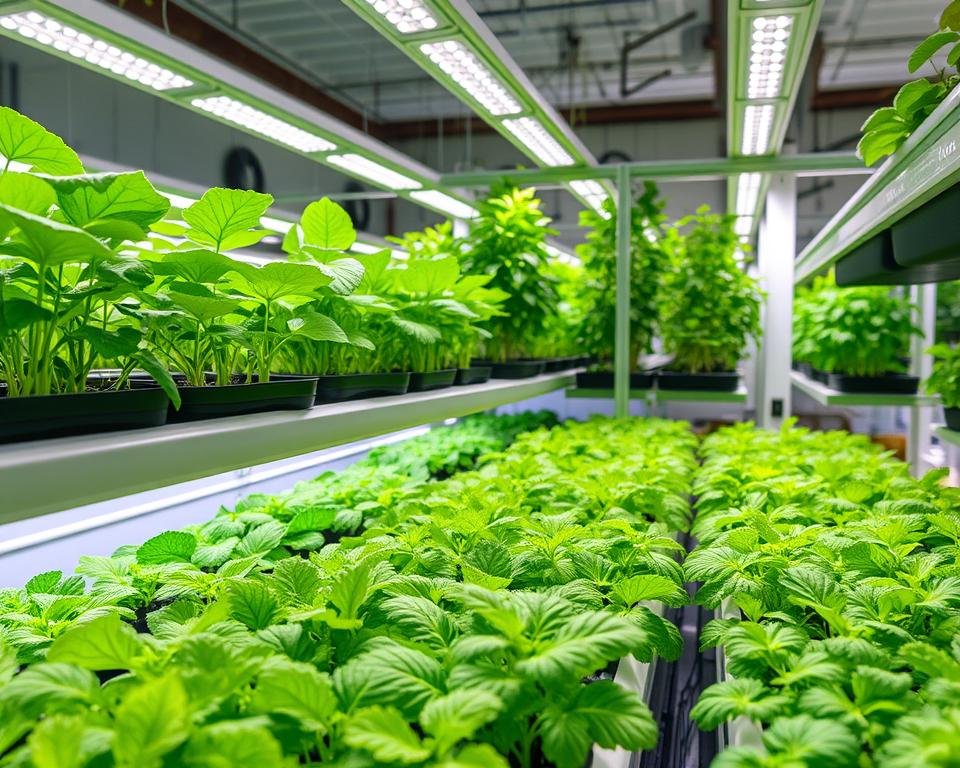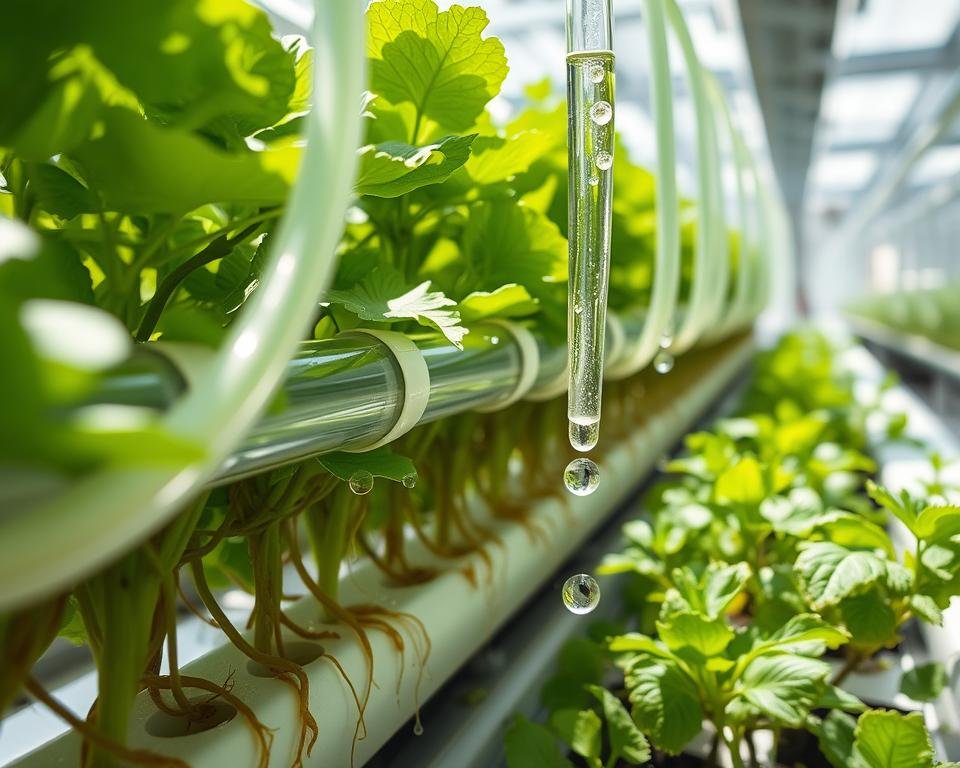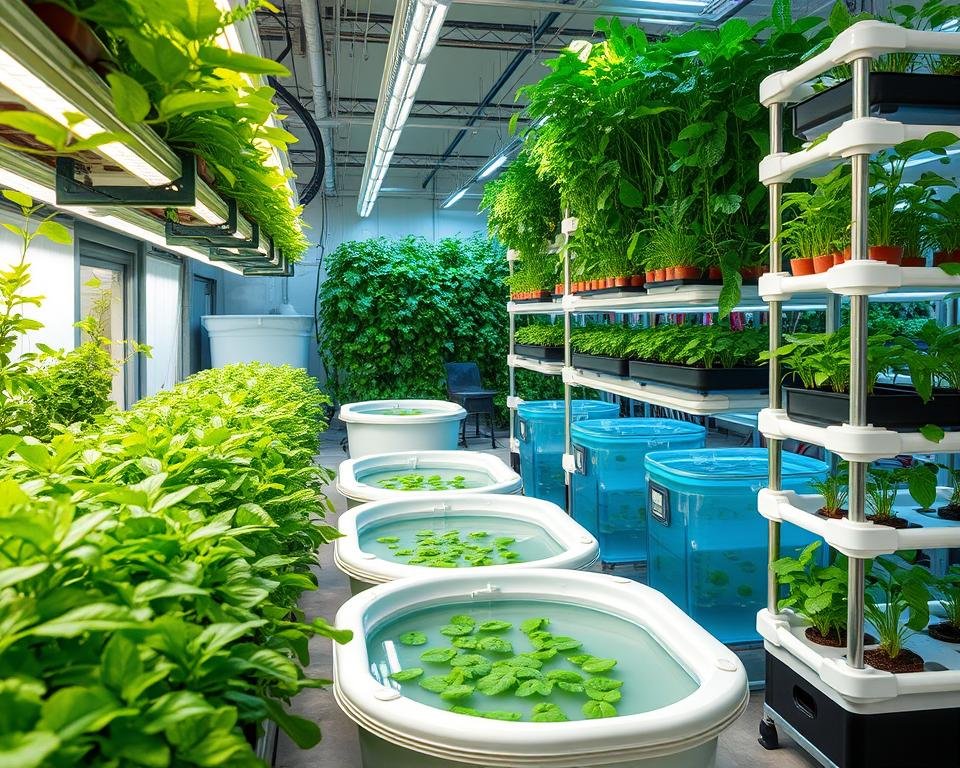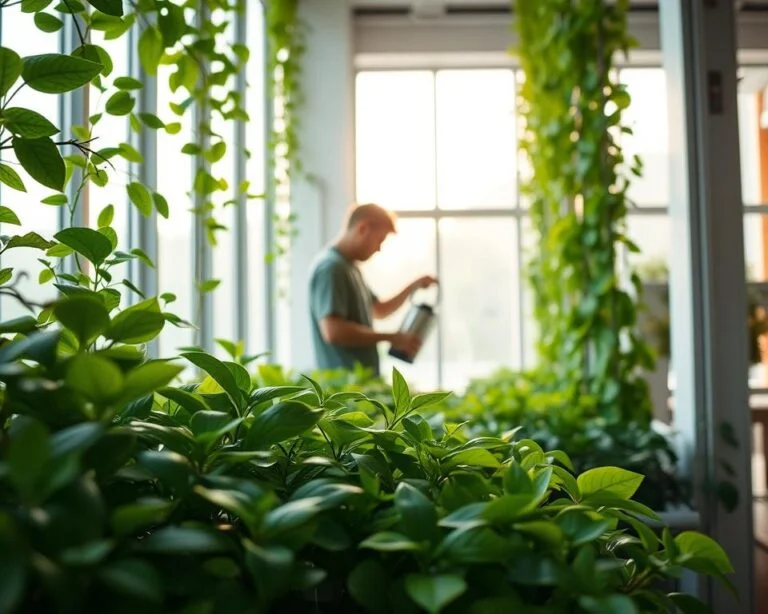How Hydroponics Works: A Simple Guide to Soilless Gardening
Imagine turning your small apartment balcony into a garden that grows fresh veggies all year. No soil needed. This isn’t just a dream—it’s the real deal with hydroponic gardening. It’s changed how we grow plants, helping both city folks and farmers.
Hydroponics grows plants in water full of nutrients, skipping the need for soil. It lets you grow veggies, herbs, and fruits in tiny spaces very efficiently. This method feeds plants directly, making hydroponic gardening a cool journey in farming.
If you love gardening or want to grow your own food, learning how hydroponics works is key. It opens doors to growing healthy food anywhere.
Key Takeaways
- Hydroponics enables plant growth without traditional soil
- Water usage is reduced by up to 90% compared to conventional farming
- Plants grow faster and produce higher yields in controlled environments
- Suitable for urban spaces and year-round cultivation
- Minimizes pest risks and chemical pesticide use
Understanding the Fundamentals of Soilless Growing
Hydroponics is a new way to grow plants that doesn’t use soil. It’s part of controlled environment agriculture. Hydroponic systems basics make growing plants more efficient and green.
What is Hydroponics and Its Core Principles?
Hydroponics grows plants without soil, using a nutrient solution for the roots. This method makes plants grow up to 5 times faster than regular gardening. It gives plants the right nutrients, oxygen, and water in a controlled space.
The Science Behind Plant Growth Without Soil
Plants in hydroponics get nutrients from a special solution. Their roots are in water or a growing medium, getting what they need for growth. This way, plants grow better and more predictably than with soil.
Key Components of a Hydroponic System
- Water Reservoir: Stores nutrient solution
- Nutrient Solution: Provides essential minerals and elements
- Air Pump: Ensures root oxygenation
- Grow Lights: Simulate sunlight for year-round cultivation
“Hydroponics transforms how we think about growing food, making agriculture possible in spaces previously considered unsuitable for cultivation.” – Agricultural Innovation Expert
| Component | Primary Function | Importance |
|---|---|---|
| Nutrient Solution | Deliver essential minerals | Critical for plant growth |
| Growing Medium | Support plant roots | Provides stability and moisture |
| Lighting System | Provide energy for photosynthesis | Enables year-round growing |
Knowing these basics helps you build a successful hydroponic garden. It will grow crops efficiently and sustainably.
Benefits and Advantages of Hydroponic Gardening

Hydroponic gardening is changing how we grow plants. It’s great for both city and country farmers. By using indoor gardening techniques, you can grow plants in a new way.
Hydroponics is amazing because it uses so little water. Traditional farming uses a lot of water. But hydroponics can use up to 90% less.
- Faster plant growth rates
- Significantly reduced water consumption
- Optimal nutrient delivery
- Compact space requirements
Your plants will grow better in a controlled space. Hydroponic systems can make plants grow 20-30% faster. They can also mature up to 50% quicker than plants grown in soil.
| Benefit | Advantage |
|---|---|
| Water Usage | 90% less water consumption |
| Growth Speed | 50% faster plant maturation |
| Pest Control | 80% reduction in pesticide use |
“Hydroponics represents the future of efficient, sustainable agriculture” – Agricultural Innovation Magazine
Urban farmers and home gardeners will love indoor gardening. These systems let you grow crops all year, no matter the weather. They also get rid of soil problems, making plants healthier and more productive.
How Hydroponics Works
Hydroponic systems change how plants grow by giving nutrients straight to the roots. They use nutrient solutions in new ways. This is different from growing plants in soil, where nutrients are not as precise.
Nutrient Delivery Systems
Hydroponics are great at managing nutrients. They use special methods to do this. Here are a few:
- Drip systems that slowly give out nutrients
- Nutrient Film Technique (NFT) with thin nutrient streams
- Deep Water Culture (DWC) where roots soak in nutrient-rich water

Root Zone Management
Managing the root zone is key in hydroponics. These systems control water and oxygen levels. This makes a perfect place for plants to grow.
Plants get exactly what they need at the right time.
Precision nutrition leads to faster growth and higher yields.
Water and Oxygen Balance
Keeping water and oxygen levels right is very important. For example, Deep Water Culture systems need:
- Water temperatures between 65-75°F
- pH levels of 5.5-6.5
- Constant oxygen flow with air stones
These careful conditions help plants take in nutrients well. This results in 35-50% more growth than regular farming.
Essential Equipment and Setup Requirements
Starting an indoor garden with hydroponics needs careful equipment choice. Your journey in controlled environment agriculture starts with knowing the key parts. These parts turn your growing space into a productive ecosystem.
To have a successful hydroponic garden, you’ll need several important pieces:
- Water reservoir or container
- Nutrient solution
- Growing medium
- Plant support systems
- Lighting equipment
- Monitoring tools
Choosing the right growing medium is key for your hydroponic system. Options like rockwool, perlite, and coconut coir help plant roots grow well.
| Equipment Type | Purpose | Recommended Specifications |
|---|---|---|
| Grow Lights | Photosynthesis Support | LED, 12-18 hours daily |
| Air Pump | Oxygen Circulation | Adjustable flow rate |
| pH Meter | Nutrient Solution Monitoring | Digital, 0.1 accuracy |
Pro tip: Get quality monitoring tools like pH and electrical conductivity (EC) meters. These help keep growing conditions perfect. They ensure your plants get what they need.
Hydroponic systems can increase crop production density by up to 10 times compared to traditional farming methods.
When planning your indoor garden, think about space. Many hydroponic systems can stack vertically. This lets you grow more in less space. A basic setup can fit in under 10 square feet, great for city living.
Popular Hydroponic Growing Systems
Hydroponic systems let gardeners grow plants without soil. They are efficient for growing herbs, vegetables, and flowers. Each system has its own benefits.

Knowing about different hydroponic systems helps you pick the right one. The most popular ones are:
- Deep Water Culture (DWC)
- Nutrient Film Technique (NFT)
- Ebb and Flow Systems
- Aeroponics
Deep Water Culture (DWC)
Deep water culture is great for beginners. Plants’ roots hang in nutrient-rich water. This setup ensures plants get water and nutrients constantly.
“Deep water culture systems are among the most straightforward hydroponic methods available today.” – Hydroponic Experts
Nutrient Film Technique (NFT)
The nutrient film technique is perfect for leafy greens and herbs. A thin layer of nutrient solution flows over the roots. This method ensures plants get enough oxygen and water.
Ebb and Flow Systems
Ebb and flow systems are versatile. They flood trays with nutrient solution and then drain. This process helps roots grow by providing oxygen.
| System | Best Plants | Difficulty Level |
|---|---|---|
| Deep Water Culture | Lettuce, Herbs | Beginner |
| Nutrient Film Technique | Leafy Greens | Intermediate |
| Ebb and Flow | Variety of Plants | Intermediate |
Each hydroponic system has its own advantages. Your choice depends on the plants you want to grow, the space you have, and your gardening experience. Try different systems to find the best one for you!
Plant Selection and Nutrition Management
Choosing the right plants and managing their nutrition are key to successful vertical farming. When starting your hydroponic garden, pick plants that do well without soil.
Best Plants for Hydroponic Systems
- Leafy Greens: Lettuce, spinach, and kale
- Herbs: Basil, mint, cilantro
- Fruiting Plants: Tomatoes, strawberries, peppers
Your nutrient solutions for hydroponics are vital for plant growth. Different plants need specific nutrients to grow well. For example, tomatoes need more potassium, while lettuce prefers nitrogen-rich solutions.
“The key to successful hydroponics is understanding your plants’ unique nutritional requirements.” – Hydroponic Expert
Nutrient Management Essentials
Managing nutrients means watching pH and electrical conductivity (EC) levels closely. Hydroponic systems let you control plant nutrition precisely. This leads to faster growth and higher yields than traditional farming.
| Nutrient | Recommended PPM | Plant Type |
|---|---|---|
| Nitrogen | 100-150 | Lettuce |
| Potassium | 180 | Tomatoes |
| Calcium | 90 | Most Vegetables |
Water quality is crucial for nutrient absorption. Reverse osmosis water eliminates 98% of impurities. This makes it perfect for delivering nutrients in your hydroponic system.
Conclusion
Hydroponics is a game-changer in soilless growing, tackling big challenges in farming. It uses 90% less water than old farming ways. This makes it a green way to grow food in cities and tight spots.
Looking into hydroponic systems shows us a way to grow crops beyond old limits. It’s not just about growing plants. Aquaponic farming links hydroponics with fish farming, making a system that uses resources well.
This method works for small gardens and big farms alike. It lets us grow food all year and get more from our crops. Hydroponics is a key to food security in the future.
As tech gets better, hydroponics gets easier and more effective. It’s great for anyone who loves gardening or works in farming. It uses less water, fights pests better, and controls growing conditions.
Starting with hydroponics can lead to a greener, more reliable food system. It shows us a future where farming is smarter, greener, and more precise. We can grow fresh, local food for our communities.







